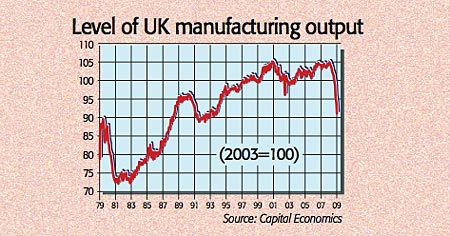
The British economy is heading for its toughest year since 1931, said Sean O’Grady in The Independent. The latest “ominous” data suggest that GDP could fall by as much as 4% this year, reckons Capital Economics. Industrial production is down a “whopping” 11.4% year on year and “there was little cause for cheer” from the British Retail Consortium’s retail sales figures, down an annual 1.8% on a like-for-like basis in February. The latest trade figures provided no respite, with the overall January goods and services deficit widening to £3.6bn, the highest since last September. “The weakness of sterling isn’t even managing to prevent exports from falling at an even sharper pace.”
Enter quantitative easing
So it’s time to press the panic button. Not content with cutting base rates to 0.5%, the Bank of England has started printing money. “Note it down in big red letters: it’s Quantitative Easing (QE) day, when the Bank wades into the market to buy British government bonds for ready money,” said the BBC’s Robert Peston. The idea is “to stimulate economic activity by increasing the amount of money in circulation”. This week the Bank began buying gilts with freshly created money; total asset purchases could hit £150bn, or 10% of GDP.
The announcement has already had a big impact – the price of medium and long gilts has risen by up to 20% since the size of the operation was disclosed. That’s good for gilt holders, but – demonstrating one of the first nasty side-effects of QE – it’s not so good for pension funds. Long-dated government bond yields are the benchmark for the long-term real rate of return in the economy, noted Anthony Hilton in the Evening Standard. This determines the valuation of pension fund liabilities and deficits. “The drop in the long-term real return last week adds one third to all liabilities across the financial system that use it as a benchmark.”
What next?
So will the newly created money do the trick by kick-starting the economy and stopping deflation? Don’t count on it. With “banks, corporations and individuals all repairing their balance sheet, who wants to borrow”, asked Breakingviews’ Ian Campbell, “and who wants to lend”? And even if growth does return, as Campbell’s colleague Edward Hadas points out, “all that extra money could easily push up prices. Inflation might strike when it’s least expected and most damaging”.